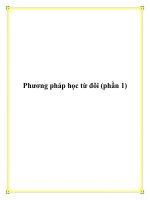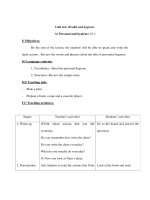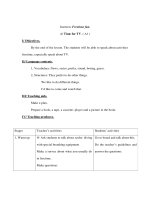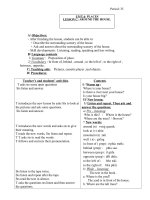How to Study phần 1 potx
Bạn đang xem bản rút gọn của tài liệu. Xem và tải ngay bản đầy đủ của tài liệu tại đây (232.27 KB, 11 trang )
William J. Rapaport
Department of Computer Science and Engineering,
Department of Philosophy,
and Center for Cognitive Science
State University of New York at Buffalo,
Buffalo, NY 14260-2000
If you are reading a printed version of this, you might be interested in the Web version, at
which has numerous links to other helpful Web sites (indicated in some printed versions by underlined phrases).
OUTLINE and INDEX:
1. Introduction
2. Manage your time
3. Take notes in class & rewrite them at home
4. Study hard subjects first & study in a quiet place
5. Read texts actively & slowly, before & after class
6. Do your homework
7. Study for exams
8. Take Exams
9. Do research & write essays
10. Do I really have to do all this?
11. Are there other websites that give study hints?
1. Introduction
How to Study:
A Brief Guide
Last Update: 3 February 2005
Note: or
material is highlighted
Everyone has a different "learning style". (A good introduction to the topic of learning styles is Claxton
& Murrell 1987. For more on different learning styles, see Keirsey Temperament and Character Web
Site, William Perry's Scheme of Intellectual and Ethical Development, Holland 1966, Kolb 1984,
Sternberg 1999.) Consequently, everyone has a different "studying style". But the way that you are
studying right now might not be the best for you. How would you know? Easy: If your grades aren't
what you'd like them to be, then you probably need to change how you study!
I am going to give you some suggestions on how to study efficiently. They worked for me when I was in
high school, college, and graduate school. Not only that, but they worked equally well for me in
humanities courses (like philosophy and literature) and in science courses (like math and computer
science). But, given that everyone's learning style is different, some of my suggestions may not work for
you, at least not without some individual modifications. Nevertheless, I urge you to try them. Most
successful students use them (or some slight variation of them).
Please feel free to send me suggestions for studying that worked for you. I will try to include them in
further versions of this guide.
2. Manage Your Time
School is a full-time job. And managing your time is important.
l
If you have a "real" job after school that you do just for fun (or for some extra spending money),
or if you participate in extra-curricular activities (whether school-related or not), keep your
priorities in mind:
Your education should come first!
l
If you must work (in order to make ends meet), you should realize the limitations that this
imposes on your study time.
How much time should you devote to studying? A recent survey in the Chronicle of Higher Education
suggested that students are not studying enough. So, how much is enough? If you assume that your
education is a full-time job, then you should spend about 40 hours/week on it. Figure that 1 academic
credit equals about 1 hour. So, if you're taking 15 credits, then you're spending about 15 hours in class.
Subtracting that from 40 gives you 25 hours that you should be spending studying at home (or in the
library).
You should spread that out over the week. Suppose you decide to study Sunday through Thursday
evenings, taking Fridays and Saturdays off (from studying, that is). Dividing that 25 hours by those 5
days gives you 5 hours of studying per night. If you think that's too much, then plan on studying in the
afternoons, too, or some of Saturday.
The above are just rules of thumb. If you're taking a 3-credit independent-study course, but you meet
with your instructor only 1 hour/week, then you should add the extra 2 hours to your at-home study
time. If you're working to earn some money, you should subtract your work hours from your free time,
not from your study time! (If you don't want to do that, then you should consider quitting your job or
reducing your course load.)
If that still seems like a lot, consider the difference between high-school courses and college courses.
The typical high-school course meets every day, for about 5 hours/week. But the typical college course
meets only about 3 hours/week, yet is supposed to be more intensive than its high-school counterpart.
That's because in college you're expected to put more of your own time into studying.
Set yourself a grade goal. If you don't meet it, cut down on non-school activities. (If you can't, because
you're working for a living, then consider dropping down to part-time schooling.)
For some tips on managing your time during exams, see below.
For some websites on time management, take a look at:
l UB Student Affairs webpage on "Time Management"
l "Time Management Skills"
l "Time Management Tips"
l "Time Management"
l "Time Management for University Students"
l or do a Google search on "time management" for more ideas.
3. Take Notes in Class & Rewrite Them at Home
Outline and Index:
1. Take Notes
2. Take Complete Notes
3. Use Abbreviations
4. Neatness Doesn't Count
5. Ask Questions & Make Comments
6. Copy Your Notes at Home
7. Don't Take Notes on a Computer
8. Don't Rely on the Instructor's Lecture Notes
3.1. Take Notes
Good studying at home begins with good notes taken in class. Just as everyone has a different learning
style, different teachers have different teaching styles (and often these clash with the students' learning
styles!): Some teachers lecture, some lead discussions, some "facilitate" individual work (as in a lab),
etc. Consequently, different classroom settings will require different note-taking techniques. But the
suggestions here are general enough to work in most situations.
3.2. Take Complete Notes
The key idea of taking good notes in class is to write down as much as possible. There are several
reasons to take notes that are as complete as possible:
1.It will force you to pay attention to what's going on in class.
2.It will keep you awake (!)
3.There will be less that you'll have to remember.
Should you concentrate on taking notes or should you concentrate on understanding what you are
learning? Paradoxically, I'd err on the side of taking notes, not understanding! Understanding can come
later, when you review your notes. But if you have incomplete notes, it will be hard for you to learn
what you didn't take notes on.
3.3. Use Abbreviations
Taking complete notes will require you to write fairly quickly and, as a consequence, to use
abbreviations
. Here are some that I use (many of which I stole from other students and teachers), to give
you an idea of how you can abbreviate. If you send text messages on your cell phone, then you know the
sort of abbreviations I'm talking about. Use them when you take notes in class!
ABBREVIATION MEANING
betw between
ccpt concept
cd could
compn computation
compnl computational
comp complete
dn description
fn function
h. human
g
(e.g., contg)
ing
(continuing)
l
(e.g., compnl)
al
(computational)
lg language
mn mean
mng meaning
n
(e.g., abbrvn)
tion
(abbreviation)
NB: note/note well/
nota bene
A related idea is based on a system of shorthand called Speedwriting: There used to be ads in the New
York City subway system that read something like this:
if u cn rd ths, u cn lrn spdwrtg
The key idea in abbreviating is to use abbreviations that will make sense to you. You can put an
abbreviation key in the margin of your notebook for any abbreviations that you make up on the spot.
3.4. Neatness Doesn't Count.
Yet another key idea of note-taking is that you don't have to be neat; you only have to be legible enough
to be able to read your notes a few hours (or, at most, a few days) later. The reason for this will become
clear later.
3.5. Ask Questions & Make Comments
If you have a question or something comes to mind as you're taking notes, you have two choices: You
can contribute to the class discussion by asking your question or making your comment. Or you can jot
your question or comment down in your notes. I suggest always doing the latter, but also doing the
pn proposition
prop property
re about (from Latin)
reln relation
qn question
r
(e.g., compr)
er
(computer)
shd should
s.t.
something/sometimes
(context should make it clear which you mean)
stmt statement
thot thought
w/ with
w/o without
wd would
wh which
& and
v or (this is a symbol from logic)
¬
not/negation sign
(this is a symbol from logic)
possible/possibly
(this is a symbol from logic)
must/necessary/necessarily
(this is a symbol from logic)
all/for all/every
(this is a symbol from logic)
some/there is/there are/there exists
(this is a symbol from logic)
former as often as possible. One reason that you should always put your question or comment in your
notes is so that you won't forget it; you can then always bring it up later, either in class or one-on-one
with the teacher or a fellow student. Another reason, of course, is that if you do bring it up in class, it
should thereby become part of the day's class notes! One technique that I use to be able to distinguish
my own questions or comments from the rest of the notes is to put them in the margin and/or to surround
them with big, bold square brackets [like this.]
By the way, if you have a question, especially if you need clarification of something that the teacher said
or wrote (possibly because it was inaudible or illegible), ask it! Do not be embarrassed about asking it! I
can guarantee you that there will be at least one other student in the class (and often many more) who
will be extremely grateful to you for having asked the very same question that they were too
embarrassed to ask, and they will come to view you as wise and brave for having asked it. (So will the
teacher!)
3.6. Copy Your Notes at Home
Notice that this section is titled "Take Notes in Class &
Rewrite Them at Home"; the title was not "Take
Notes in Class &
Study Them at Home". Of course you should study your class notes at home; but just
(re-)reading them is too passive. One of the themes of this guide is that studying must be active. It is all
too easy when just reading passively to have your mind wander or even to fall asleep:
Moreover, notes are often incomplete or sketchy; just reading such notes won't help. And a few days or
months after you take them, they may very well be illegible or incomprehensible. Finally, if you don't do
something active with your notes, you run the risks of having unorganized notes or of misplacing them.
What I suggest is that you study your notes by re-writing them. For each class, buy a separate notebook
from the one you take your notes in. I recommend a "composition" or spiral notebook, not a looseleaf
notebook, for your "permanent" (i.e., re-written) notes. Then, as soon as possible after class (preferably
that evening or the next), copy your notes into your permanent notebook.
The main idea behind re-writing your "raw" class notes (besides making them more legible and
organized) is that the very act of copying them is one of the best ways of studying them! Further study
of your class notes can then be done from these "cooked" ones that are neater, more legible, more
organized, and more complete. I will suggest ways to do this
later
.
Use this opportunity to fill in gaps from your memory while they are still fresh in mind. You may find
that you have questions, perhaps something you missed or don't understand, or even a "substantive"
question. If so, good! Make a note of your question and ask it in class next time!
Use this opportunity to (re-)organize your notes in a more logical or coherent fashion. You could write
your permanent notes in an outline form if that seems suitable: You don't have to follow any "official" or
formal outlining style (e.g., using the I.A.1.(a)(i) format or the (sometimes silly) rule that there must
always be at least two subsections, never just one) after all, these are your notes. Personally, I like to
number main ideas (and separate them with a line), using an "indented bullet" style for details:
1. Main idea 1
- detail 1
- detail 2
- further detail 2.1
- detail 3
- further detail 3.1
- further detail 3.2
2. Main idea 2
3. Main idea 3
etc.
3.7. Don't Take Notes on a Computer
By the way, I do not recommend taking class notes on a laptop computer. Certainly you should not do
this unless you are a very good typist and have "compiled" your word-processing or text-editing
program into your fingertips. (In any case, typing can be very noisy and disturbing to your fellow
students!) Also, typing class notes into a computer file can be inconsistent with my recommendation to
re-write your class notes. Of course, you can edit your computer file later, but editing is not the same as
copying, and I am recommending copying as a means to studying (for one thing, it forces you to (re-)
read all your notes). Of course, you can copy your raw notes into a neater computer file; this may be a
matter of taste, but I find that I have a firmer grasp of what I write if I handwrite it than if I type it. (As
Usama Fayyad of Microsoft Research has said, computers are "great at bookkeeping but not yet great at
recording impromptu ideas, thoughts, feelings. For that, paper is still far superior. You can hold it, fold
it, put it in your pocket, look at it again later when it's convenient" (as quoted in Swerdlow 1999: 130).)
3.8. Don't Rely on the Instructor's Lecture Notes
Some instructors provide their own set of lecture notes, often on the Web or in PowerPoint (or some
other format). These can be useful,
but you should not rely on them
. If all you do with them is print
them out, maybe read them once, and save them, they are useless, because you are using them passively
.
You need to treat them just as you would with your own lecture notes: Re-write them! Better yet: Use
them to fill in gaps in your own re-written lecture notes, and to check whether you had any mistakes in
your own notes. (You may find new material in the instructor's notes that was not discussed in class, or
you may find material in your own notes that
was
discussed in class but did not find their way into the
prepared notes.)
4. Study Hard Subjects First & Study in a Quiet Place
Study hard subjects first.
Each night (or day) when studying or doing your homework, do those
subjects first for which you need to be alert and energetic. Leave the easier, or more fun, subjects to
later.
Study in a quiet place
, with as few distractions as possible. Do not listen to music or TV: It is virtually
impossible to do two things at once if one of them is studying.
5. Read Texts Actively & Slowly, before & after Class
Outline & Index:
1. Read actively, not passively
2. Read slowly
3. Highlight the text in the margin
4. Make notes in the margin
5. Keep a notebook
6. Read literature quickly and passively the first time
7. Read before and after class
5.1. Read Actively, Not Passively
By 'text', I mean whatever you have to read: It might be a text book, a work of fiction, a poem, an essay,
an article from a journal or magazine, or even a class handout. With one major exception, you should
not read passively. That is, don't just read the text straight through without thinking about what you're
reading.
If you read without thinking, I guarantee that your mind will eventually wander off, your eyes will
eventually glaze over, and you will fall asleep it's a form of self-hypnosis. So you must read actively.
To use computer jargon, you must turn the inert medium of text on paper to an interactive medium, in
which you have a "conversation" with the text, as you might if you could be talking to the author.
5.2. Read Slowly.
The first step in reading actively is to read s-l-o-w-l-y
. Here is an algorithm (i.e., a procedure) for how to
read any text, in any subject, slowly and actively:
WHILE there is a next sentence to read, DO:
BEGIN (* while *)
Read it, SLOWLY;
IF you do not understand it, THEN
BEGIN (* if *)
re-read the previous material, SLOWLY;
re-read the incomprehensible sentence, SLOWLY;
IF you still don't understand it, THEN
ask a fellow student to explain it;
IF you still don't understand it, THEN
ask your Teaching Assistant (TA) to explain it;
IF you still don't understand it, THEN
ask me;
IF you are in an upper-level course & you still don't understand it, THEN
write a paper about it (!)
END (* if *)
END; (* while *)
Since there is no next sentence (because the Boolean test in the WHILE is false), you've understood the
text!
This algorithm has three major advantages:
1.It forces you to actively think about each sentence you read before you go on to read the next one.
2.It slows you down, so that you don't read past the point at which you don't understand. This is
especially important in mathematical and scientific subjects.
3.It can help you get help from your teacher, because you can show your teacher exactly where you
got lost. It is always much better to show your teacher exactly what it is that you don't understand
than it is to just say that you don't understand the material.
4.Note that it also provides you an opportunity to interact with your instructors and fellow students!
For more information on slow reading, see:
1.Fletcher, Lancelot R. (1994), "Slow Reading Lists (and the Meaning of Slow Reading)"
¡ Note: If you scroll down about halfway on the above link, you'll reach the section called "What Do I Mean by
"Slow Reading"?".
2.Daly, Robert (2003), "Slow Reading: Why it Matters, How to Do It, How to Teach It"
5.3. Highlight the Text in the Margin
There are some other tricks for active reading. One, of course, is to highlight important or interesting
passages. There are several ways to do this. The worst is to use a yellow highlighting marker (or hot
pink, or whatever color you like). The main problem with this is that you will tend to find almost every
sentence to be important or interesting. As a consequence, every page will become yellow (or hot pink,
or whatever). Not only does this defeat the purpose of highlighting because if everything has been
highlighted, then really nothing has been! but the pages of your text will become damp, curl up, and be
generally messy.
This technique can have other problems, too:









